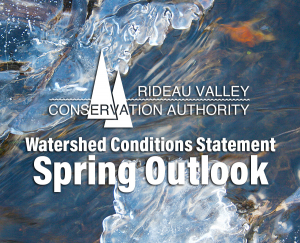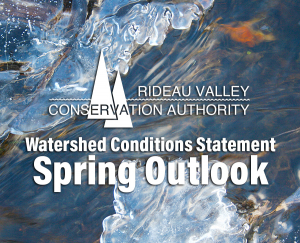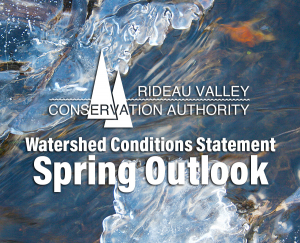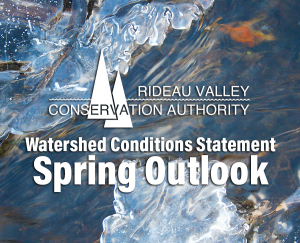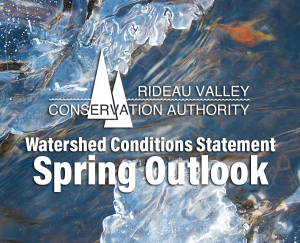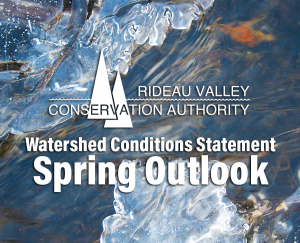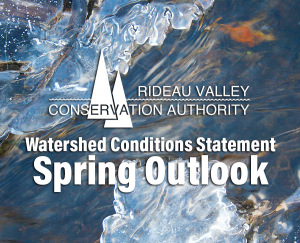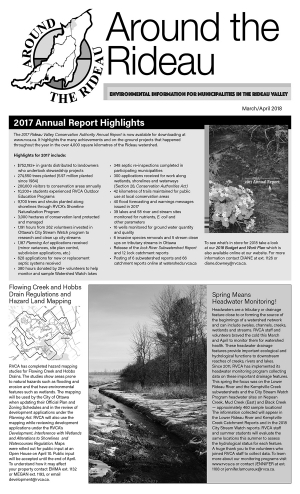Super User
Lakes in Upper Rideau Watershed Reaching Flood Level
April 28, 2018 – This message is specific to Bobs and Christie Lakes but may apply to other lakes in the area where remotely accessible monitoring equipment is not installed. Property owners are advised to go to their cottage properties and assess conditions for themselves.
Rain overnight has caused levels on Bobs and Christie Lakes to increase to flood levels. Additional rain forecast for today (Saturday) and Sunday will cause further increases. Some relief is expected on Monday and Tuesday. More rain is forecast for later in the week that will slow the decline on both lakes.
Levels of Bobs and Christie Lakes are being monitored closely by Parks Canada staff and operation of the dam at Bolingbroke will be done as required to minimize impacts on the two lakes.
Note that streambanks are slippery and any remaining ice cover on streams, ponds and lakes will be hazardous. Children and pets should be kept away from all watercourses as levels fluctuate with the spring weather.
More Rain Expected to Raise Water Levels Again
April 24, 2018 – Water levels are expected to rise again in the Rideau River watershed as a result of meltwater from the last of the snow, flow from thawing soil and rain forecast for Wednesday and Thursday.
Daytime temperatures are expected to approach 20 degrees over the rest of the week and stay above freezing at night. This will cause the remaining snow in the upper watershed to melt and, along with thawing water from the soil, begin to work its way down through the system. Rain in the order of 20 to 30 millimetres is forecast for the next two days which, in combination with the melt runoff, can be expected to cause water levels to rise.
Flooding is not expected but the levels of Bobs and Christie Lakes are being monitored closely by Parks Canada staff and operation of the dam at Bolingbroke will be done as warranted to minimize any impacts on the two lakes.
Access issues in the low-lying communities on the Long Reach of the Rideau between Kars and Kemptville such as Hilly Lane and Cedar Beach could occur as a result of the increasing flows.
Note that streambanks are slippery and any remaining ice cover on streams, ponds and lakes will be hazardous. Children and pets should be kept away from all watercourses as levels fluctuate with the spring weather.
More Rain Expected to Raise Water Levels Again
April 24, 2018 – Water levels are expected to rise again in the Rideau River watershed as a result of meltwater from the last of the snow, flow from thawing soil and rain forecast for Wednesday and Thursday.
Daytime temperatures are expected to approach 20 degrees over the rest of the week and stay above freezing at night. This will cause the remaining snow in the upper watershed to melt and, along with thawing water from the soil, begin to work its way down through the system. Rain in the order of 20 to 30 millimetres is forecast for the next two days which, in combination with the melt runoff, can be expected to cause water levels to rise.
Flooding is not expected but the levels of Bobs and Christie Lakes are being monitored closely by Parks Canada staff and operation of the dam at Bolingbroke will be done as warranted to minimize any impacts on the two lakes.
Access issues in the low-lying communities on the Long Reach of the Rideau between Kars and Kemptville such as Hilly Lane and Cedar Beach could occur as a result of the increasing flows.
Note that streambanks are slippery and any remaining ice cover on streams, ponds and lakes will be hazardous. Children and pets should be kept away from all watercourses as levels fluctuate with the spring weather.
Long Reach of Rideau River at Risk of Access Flooding
April 18, 2018 – The snow and ice accumulation over the last several days raises the possibility of flooding in parts of the Rideau system as warmer conditions arrive on Friday.
Rain and some melting has caused streamflows to increase throughout the watershed. Daytime temperatures above 10 degrees through the coming weekend and into next week can be expected to melt the remaining snow and ice. There is the potential for this meltwater to cause access issues in the low-lying communities on the Long Reach of the Rideau between Kars and Kemptville. Tributary streams such as Stevens and Cranberry Creeks in the North Gower area can be expected to overtop their banks.
The next occurrence of precipitation is not expected until next Wednesday when 20 to 30 millimetres could fall. Such rain is expected to prolong but not worsen the situation.
With water levels elevated and standing water in ditches and fields, the Rideau Valley Conservation Authority (RVCA) reminds the public to exercise extreme caution around all water bodies. Streambanks are slippery and any remaining ice cover on streams, ponds and lakes will be hazardous. Parents are advised to keep their children and pets away from all watercourses as levels fluctuate with the spring weather.
Long Reach of Rideau River at Risk of Access Flooding
April 18, 2018 – The snow and ice accumulation over the last several days raises the possibility of flooding in parts of the Rideau system as warmer conditions arrive on Friday.
Rain and some melting has caused streamflows to increase throughout the watershed. Daytime temperatures above 10 degrees through the coming weekend and into next week can be expected to melt the remaining snow and ice. There is the potential for this meltwater to cause access issues in the low-lying communities on the Long Reach of the Rideau between Kars and Kemptville. Tributary streams such as Stevens and Cranberry Creeks in the North Gower area can be expected to overtop their banks.
The next occurrence of precipitation is not expected until next Wednesday when 20 to 30 millimetres could fall. Such rain is expected to prolong but not worsen the situation.
With water levels elevated and standing water in ditches and fields, the Rideau Valley Conservation Authority (RVCA) reminds the public to exercise extreme caution around all water bodies. Streambanks are slippery and any remaining ice cover on streams, ponds and lakes will be hazardous. Parents are advised to keep their children and pets away from all watercourses as levels fluctuate with the spring weather.
Jebbs Creek Wetland Embayment Creation Project
The Jebbs Creek Wetland Embayment Creation Project converted a small area of existing meadow habitat in the Rideau Valley Conservation Authority’s Perth Wildlife Reserve Conservation Area to a series of small riverine wetland embayments along the shoreline of Jebbs Creek within Tay Valley Township in Eastern Ontario.
Jebbs Creek is a tributary in the Tay River watershed, which supports a warm/cool water fishery. The purpose of the Jebbs Creek Wetland Embayment Creation Project was to create 1,600 m² of new spawning, nursery, rearing, and feeding habitat for the 20 species of fish that reside in Jebbs Creek.
The Kemptville District of the Ministry of Natural Resources and Forests manages the Tay River watershed for an extremely diverse fishery which includes northern pike (Esox Lucius), smallmouth bass (Micropterus dolomieu), largemouth bass (Micropterus salmoides) and walleye (Sander vitreus).
Northern pike is a local sport fish, well known for its large size and predatory nature. Despite its reputation as a top predator, northern pike are particularly sensitive during spawning and are often subject to high egg mortality; therefore, it is crucial to ensure that suitable spawning habitat exists to support this species. Through a multi-tier approach, the goal was to create and maintain a suitable spawning and nursery site for northern pike along Jebbs Creek, while helping to improve shoreline stability, riparian habitat and water quality. The feature also provides a small riverine wetland embayment along Jebbs Creek which will provide important habitat for breeding birds, amphibians, turtles nesting habitat with a goal to increase overall biodiversity.
2018 Construction highlights:
- 5 days of construction
- 1600 m² of fish habitat created
- 5.5 kg of shoreline and wetland seed mixes were installed around the wetland feature
- 5.0 kg of meadow seed mix installed in the fill deposition area for pollinator habitat
- 15 volunteers participated in the planting day for a total of 75 volunteer hours
- 125 native shrubs and trees planted around the new wetland feature
Jebb's Creek Plan View Habitat Structure (PDF)
Jebb's Creek Plan View Contours (PDF)
Post Construction Phase monitoring is scheduled for the spring/summer in 2019, 2020, 2022 and 2024.
Thank you to our Otty Lake Association volunteers!
Project Objectives
- Enhance fish habitat by creating new spawning, nursery, rearing and feeding habitat for the fish community of Jebbs Creek (target species northern pike)
- Improve food supply for aquatic and terrestrial species through increasing overhanging vegetation along the shoreline.
- Improving the function of adjacent wetland habitats for aquatic species
- Create a quiet backwater area adjacent to the main current of Jebbs Creek.
- Provide winter and summer refuge areas for fish.
- Protect water quality and enhance wildlife habitat by establishing a naturalized buffer with native species of trees and shrubs
- Altering elevations to create conditions more suitable for more diverse submergent and emergent aquatic vegetation
- Enhance recreational and educational opportunities at the site by installing educational signage
- Engage and educate community members by involving volunteers in the process and providing a demonstration site that shows a variety of cost-effective methods to protect and enhance shorelines and wildlife habitats.
- Partnership opportunities with various groups and the Conservation Authority.
Project Description
Project implementation was carried out by the RVCA and partners. A variety of techniques/applications were carried out, including:
- The removal of fill from the existing shoreline to create a series of small embayment’s with a variety of slope conditions
- In-water planting of aquatic sedges and grasses known to be favorable for northern pike spawning
- Installation of wood structure to further enhance nursery habitat
- Re-vegetation of the riparian area by planting native trees, shrubs and wetland vegetation
- Maintain the pathway system adjacent to the embayment feature to continue access for recreational use
- Deposit the excess fill in specified areas in the adjacent field outside of the regulatory area and seed these areas with a pollinator seed mix to support pollinator habitat
- The installation of an interpretive sign along the adjacent existing pathway, with partner logos, describing the project benefits from a watershed management perspective
Project Timeline
- (2015-2018) background data collection to inform the detailed design process
- December/January 2017/18 Refine and further develop the wetland embayment proposal
- February/March/April 2018 prepare Detailed Design (contour plan, cross section plan, landscape plan, structures plan)
- April 2018 site visit with RVCA/MNRF staff
- June 2018 review of plans for permits and tender package for potential contractors
- July/August 2018 Around the Rideau announcing the project and partners prior to construction
- September 2018 Construction of the wetland feature
- November/December 2018 Around the Rideau announcing completion of the project and showing construction and volunteer photos
- Post effectiveness monitoring 2019, 2021, 2023 (year 1,3,5)
Project Partners:


Information:
April 11, 2018 – A weather system out of the mid-west U.S. has the potential to bring several forms of precipitation in significant amounts in to eastern Canada over the next week.
Snow, rain and freezing rain may fall beginning tonight with showers or flurries. Tomorrow, rain is forecast to fall through the afternoon. Rain is expected to begin again late on Friday morning and continue into Saturday, changing to snow in the early morning finishing with as much as 20 centimetres. Rain is presently expected to resume on Sunday and continue into Monday.
If the full amount of forecast precipitation falls, there is the potential for minor flooding to occur in the Long Reach of the Rideau near Kemptville. The lower lying communities in that area may have access issues.
Water levels throughout the watershed are below average for the time of year so there is capacity to accommodate some of the runoff with little impact. Cooler than normal temperatures are forecast which could mean that the runoff process will be slowed to an extent with freezing temperatures overnight. Temperatures closer to spring-like are not expected until the end of next week.
This weather system has the potential to develop into a more significant event over the next five days. RVCA staff will continue to monitor and further statements will be issued if conditions warrant.
Rideau Valley Conservation Authority (RVCA) reminds the public to exercise extreme caution around all water bodies. Streambanks are slippery and any remaining ice cover on streams, ponds and lakes will be hazardous. Parents are advised to keep their children and pets away from all watercourses as levels fluctuate with the spring weather.
April 11, 2018 – A weather system out of the mid-west U.S. has the potential to bring several forms of precipitation in significant amounts in to eastern Canada over the next week.
Snow, rain and freezing rain may fall beginning tonight with showers or flurries. Tomorrow, rain is forecast to fall through the afternoon. Rain is expected to begin again late on Friday morning and continue into Saturday, changing to snow in the early morning finishing with as much as 20 centimetres. Rain is presently expected to resume on Sunday and continue into Monday.
If the full amount of forecast precipitation falls, there is the potential for minor flooding to occur in the Long Reach of the Rideau near Kemptville. The lower lying communities in that area may have access issues.
Water levels throughout the watershed are below average for the time of year so there is capacity to accommodate some of the runoff with little impact. Cooler than normal temperatures are forecast which could mean that the runoff process will be slowed to an extent with freezing temperatures overnight. Temperatures closer to spring-like are not expected until the end of next week.
This weather system has the potential to develop into a more significant event over the next five days. RVCA staff will continue to monitor and further statements will be issued if conditions warrant.
Rideau Valley Conservation Authority (RVCA) reminds the public to exercise extreme caution around all water bodies. Streambanks are slippery and any remaining ice cover on streams, ponds and lakes will be hazardous. Parents are advised to keep their children and pets away from all watercourses as levels fluctuate with the spring weather.
Participant Guide
In Accordance with the Participant Waiver and Release
For a PDF copy of this document, click here.
RVCA Event Co-ordinator Responsibilities
Safeguard the safety and security of Participants by:
- Ensuring they receive appropriate training to complete each task;
- Ensuring they do not use RVCA power equipment or operate an RVCA vehicle;
- Informing them, in writing, of any known potential site hazards and ensuring theyhave appropriate Personal Protective Equipment (PPE);
- Providing them with appropriate supervision and feedback;
- Understanding and appropriately accommodating personal physical limitations.
Respect the rights of Participants and protect their personal information;
Provide Participants with a meaningful experience.
Participant Rights
- Receive appropriate information to understand the risks involved with the event and to appreciate the purpose of the event;
- Receive appropriate training and supervision;
- Decline to perform any tasks which you may feel are unsafe;
- Be treated with respect by RVCA staff and other participants;
- Provide feedback on the event to improve future activities.
Participant Responsibilities
- Ensure you have your own transportation to the work site and/or RVCA office, as directed;
- Read and sign the Participant Waiver and Release before participating in the event;
- Follow policies, protocols and procedures established by the RVCA and as directed by the Event Co-ordinator;
- Clarify any uncertainties with the Event Co-ordinator;
- Take reasonable care when carrying out your tasks;
- Inform the Event Co-ordinator of any physical limitations or restrictions;
- Wear Personal Protective Equipment or clothing identified as mandatory by your Supervisor, including but not limited to safety clothing such as steel-toed boots, sunscreen or other appropriate outdoor wear;
- Work cooperatively with RVCA staff, recognizing and appreciating differences of opinion;
- Be considerate, respect competencies and work as a team with all staff and other Participants;
- Use time wisely and not interfere with performance of others;
- Immediately report all accidents and injuries to the Event Co-ordinator;
- While participating in events for the RVCA, smoking and using or possessing illegal drugs or alcohol is prohibited. Participants should ask the Event Co-ordinator to identify designated smoking areas.
Potential Hazards
You may be exposed to the following hazards. Hazards specific to each work site will be described on site.
- Steep slopes
- Unsure footing
- Uneven bottom
- Fast moving current
- Poor visibility
- Scour holes
- Poor water quality
- Metal objects in water
- Extreme temperatures, rain, snow
- Hazardous waste such as chemicals, broken glass, syringes/needles)
- Toxic plants such as poison ivy, giant hogweed, wild parsnip
- Animals
- Insects including Lyme-carrying Blacklegged Ticks
HR Forms/Volunteers/Participant Guide November 17, 2017





